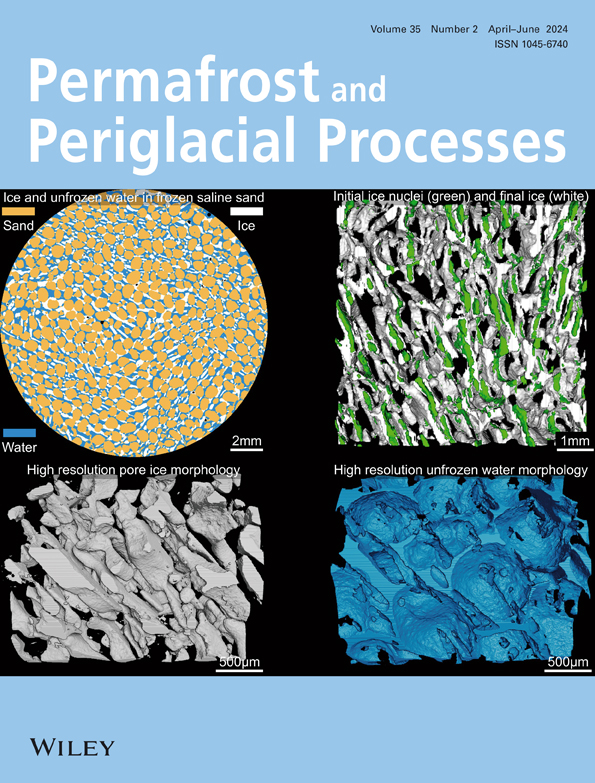Internal structure of a large, complex rock glacier and its significance in hydrological and dynamic behavior: A case study in the semi‐arid Andes of Argentina
IF 3.3
3区 地球科学
Q2 GEOGRAPHY, PHYSICAL
引用次数: 8
Abstract
This paper presents an analysis of the internal structure, hydrogeology and dynamics of a large, complex, multilobate and multiroot rock glacier combining electrical resistivity tomography (ERT), hydrochemical data and differential interferometry synthetic aperture radar (DInSAR). The rock glacier consists of a series of overlapping lobes that represent different advancing stages with different degrees of conservation. The ERT surveys characterize the active layer and the upper part of the permafrost layer, the latter showing a heterogeneous geometry and electrical resistivity values ranging from 7 to 142 kΩm. Hydrochemical data argue for both the existence of different disconnected water flow pathways inside the rock glacier and the remarkable ionic concentrator effect of this landform. The horizontal displacement from October 2014 to April 2017 shows greatest magnitudes in the upper sector of both tongues, reaching speeds of up to 150 cm/year. The active frontal sector shows a displacement rate of 2–4.5 cm/year. This study contributes to knowledge of the material properties of rock glaciers, which are considered to represent important reservoirs/water resources, and their influence on the distribution of mountain permafrost, hydrology, and dynamics. Finally, to the best of our knowledge, the possible influence of the metal content of the ground on the resistivity values recorded for mountain permafrost is highlighted for the first time.大型复杂岩石冰川的内部结构及其在水文和动力行为中的意义——以阿根廷半干旱安第斯山脉为例
本文结合电阻率层析成像(ERT)、水化学数据和差分干涉合成孔径雷达(DInSAR)技术,对某大型复杂多片多根岩石冰川的内部结构、水文地质和动力学进行了分析。岩石冰川由一系列重叠的裂片组成,这些裂片代表了不同的前进阶段,具有不同的保存程度。ERT测量描述了活动层和永久冻土层的上部,后者显示了非均匀的几何形状和电阻率值,范围从7到142 kΩm。水化学数据表明,岩石冰川内部存在不同的不相连的水流路径,而且这种地貌具有显著的离子浓缩器效应。2014年10月至2017年4月的水平位移显示,两舌上部的位移幅度最大,速度可达150厘米/年。活跃锋面扇区的位移速率为2 ~ 4.5 cm/年。该研究有助于了解岩石冰川的物质性质及其对山地多年冻土分布、水文和动力学的影响,岩石冰川被认为是重要的水库/水资源。最后,据我们所知,首次强调了地面金属含量对山地永久冻土记录的电阻率值的可能影响。
本文章由计算机程序翻译,如有差异,请以英文原文为准。
求助全文
约1分钟内获得全文
求助全文
来源期刊
CiteScore
9.70
自引率
8.00%
发文量
43
审稿时长
>12 weeks
期刊介绍:
Permafrost and Periglacial Processes is an international journal dedicated to the rapid publication of scientific and technical papers concerned with earth surface cryogenic processes, landforms and sediments present in a variety of (Sub) Arctic, Antarctic and High Mountain environments. It provides an efficient vehicle of communication amongst those with an interest in the cold, non-glacial geosciences. The focus is on (1) original research based on geomorphological, hydrological, sedimentological, geotechnical and engineering aspects of these areas and (2) original research carried out upon relict features where the objective has been to reconstruct the nature of the processes and/or palaeoenvironments which gave rise to these features, as opposed to purely stratigraphical considerations. The journal also publishes short communications, reviews, discussions and book reviews. The high scientific standard, interdisciplinary character and worldwide representation of PPP are maintained by regional editorial support and a rigorous refereeing system.

 求助内容:
求助内容: 应助结果提醒方式:
应助结果提醒方式:


